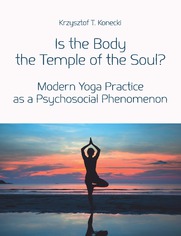Is the Body the Temple of the Soul? Modern Yoga Practice as a Psychological Phenomenon - Onepress

ISBN: 978-8-3796-9820-2
stron: 226, Format: ebook
Data wydania: 2016-03-15
Ksi─Ögarnia: Onepress
Cena ksi─ů┼╝ki: 17,58 z┼é (poprzednio: 21,44 z┼é)
Oszczędzasz: 18% (-3,86 zł)
Hatha-yoga in Western culture is often perceived as the practice of physical exercises (practice of the asana position), usually done to improve one’s health and emotional state. Even if that is the case, it is still based on the rule of “the silencing of the modifications of the mind.” It is about a containment of mind dispersion in terms of non-important, minute, everyday issues, which are not important for the basis of our existence, balance and inner harmony, the unity of body and mind. Even if we train only for our health and for improvement of our physical fitness, then the end result, in the case of many physical and sports activities, is stopping mind movement. The full concentration on one action, on one point in space, might not have any metaphysical meaning for us, but it still remains full concentration. This can be achieved by patiently practicing hatha-yoga.
Osoby które kupowały "Is the Body the Temple of the Soul? Modern Yoga Practice as a Psychological Phenomenon", wybierały także:
- Projekty restrukturyzacyjne 0,00 zł
- Rozw 0,00 zł
- Metody ilo 0,00 zł
- ABC wsp 0,00 zł
- Mikroekonomia dla bystrzaków 39,67 zł, (11,90 zł -70%)
Spis tre┼Ťci
Is the Body the Temple of the Soul? Modern Yoga Practice as a Psychological Phenomenon eBook -- spis tre┼Ťci
Foreword (Michał Szczepanik) 7
Introduction 9
Chapter 1. Philosophy and hatha-yoga practice. Para-religious aspects of hatha-yoga 21
1.1. Introduction 21
1.2. Yoga – the perspectives of religious studies scholar and the perspective of yoga practitioner 22
1.3. Yoga and society – “religion of everyday life” 29
1.4. Conclusions 35
Chapter 2. The social world of yoga practice 39
2.1. What is the social world? 39
2.2. Hatha-yoga practitioners and their social world – arenas and legitimization 40
2.3. The intersection of the worlds 48
2.3.1. Intersection of the world of yoga practice and the world of climbing 48
2.3.2. Intersection of the world of conventional medicine and alternative medicine 48
2.3.3. Intersection of the world of business corporations and the world of yoga practice 50
2.3.4. Intersection of the world of yoga and pop-culture 53
2.4. A disagreement about hatha-yoga origin. The vision of Marc Singleton 54
2.5. Conclusions 67
Chapter 3. Commonsense definitions of yoga and its meaning for practitioners 69
3.1. Introduction 69
3.2. Individual interpretations of hatha-yoga 70
3.3. Conclusions 80
Chapter 4. The process of becoming a hatha-yoga practitioner 83
4.1. Introduction 83
4.2. Introductory phase – construction of motives and first steps 85
4.2.1. Constructing motives 85
4.2.2. First steps – beginning of the practice 91
4.2.3. Noticing the effects 98
4.3. The phase of fuller recognition of psychophysical effects, and ascribing appropriate meanings to them 105
4.4. Phase of fuller recognition of the spiritual (para-religious) aspects of hatha-yoga 117
4.5. Conclusions 136
Chapter 5. Visual transmission of knowledge and the meaning of corporality and gestures in the social world of yoga practice 141
5.1. Introduction 141
5.2. The method of studying corporality with the usage of visual techniques 147
5.3. What do I see and feel when I practice? Analysis of the interviews data 150
5.3.1. What do I see when somebody else practices? The analysis of films from the Internet used for interviews 152
5.3.2. What do I feel when I practice? Analysis of the movie-elicited interviews 159
5.3.3. Non-passable knowledge. Difficulties with verbal interpretations and description of asanas 159
5.3.4. Body empathy based on visualization 162
5.4. The role of the teacher and the correctness of asana performance 173
5.5. Conclusions 174
Chapter 6. Emotions and yoga practicing. Working on emotions and achieving “emotional culture” without emotions 177
6.1. Introduction 177
6.2. Working on emotions – explanations based on practitioners’ statements 183
6.3. Conclusions 190
Chapter 7. Teacher and guru in hatha-yoga practice 195
7.1. Introduction 195
7.2. Teacher-student interactions 197
7.3. Conclusions 207
Conclusions 209
Bibliography 217





